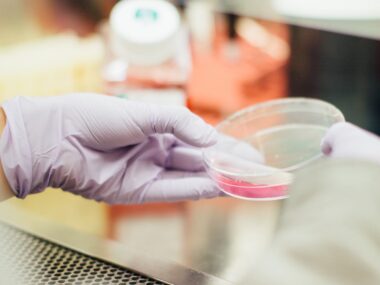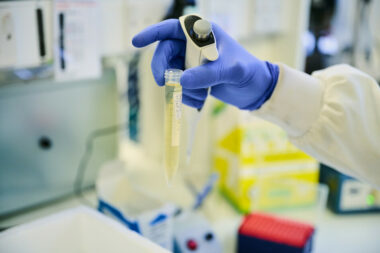Every day we’re working towards a future with effective treatments and ultimately cures for all muscle wasting and associated neuromuscular conditions. We believe this as passionately now as we did when we were established in 1959. It is this vision that unites us all and continues to drive our research strategy.
The role of animals in research
Animals play a vital role in understanding the causes of health conditions and in testing new treatments. Currently, most research studies start with clinically examining the condition in patients and then comparing cells from the patient with cells from people who don’t have the condition.
The researchers look for differences in the genes from the two types of cells, differences in the products of the genes and how the cells grow and change into their final form. They can expose the cells to drugs or make genetic changes to see what these do to the cells of the patient, and whether these changes make the cells more like those from people without the condition.
However, for muscle wasting conditions, such cell cultures do not represent the complex three-dimensional structure of a working muscle with its interactions with blood vessels, nerves and other cell types.
If the characteristics of a drug are known, then researchers can use computer models to predict:
- how it will be distributed throughout the body, and
- whether it may be suitable for treating the disease in question when given to humans.
However, in many cases with a new drug, such information will not be available. In addition, the predictions that are derived from unaffected animals may not apply in disease. Therefore, in these cases, researchers need to use an animal model of the human disease to assess the potential of a treatment, for it to be clinically effective.
Most of the animals used in research are mice or rats. Mice are particularly useful as there are good techniques for changing the genes of mice. This has meant it has been possible to generate a large number of mouse models of human diseases.
In some cases, disease-causing genetic changes occur naturally, such as the mdx mouse model of Duchenne muscular dystrophy (DMD). Mice are small, easy to house, breed well and are cheaper to work with compared to large animals. However, mice are very tough and may not show potential side-effects of the treatment.
Sometimes, it is possible to use a larger animal model. For example, there are dog models of DMD, although these aren’t used often.
The animal models of disease are used to show that the treatment is effective. However, additional tests for harmful side-effects in unaffected animals are required before a drug is allowed to be used in a human trial. The animals most often used in this type of regulatory toxicity testing are rats, dogs or monkeys.
The use of animals in research in the UK is controlled by national legislation through the Animals (Scientific Procedures) Act, or ASPA for short. This requires that:
- the place of research is of an appropriate standard (Establishment Licence)
- the plan of work is approved (Project Licence), and
- the people carrying out the work have been appropriately trained (Personal Licence).
In many countries across the world, closely related sets of regulations are in force.In the UK, the operation of ASPA is controlled by the Home Office, which has veterinary or medically trained Inspectors who determine if licences should be granted. They can also conduct unannounced inspections of any approved establishment. Central to this regulation is a careful consideration of the harm to the animals weighed against the potential benefit to humans (or other animals).
Scientists are required to replace animal work with other methods wherever possible, to reduce the number of animals used to the minimum necessary:
- to obtain reliable results, and
- to refine the experimental procedures.
The aim is always to minimise any pain and suffering.
Therefore, we can rightly claim to have one of the best systems in the world for controlling the use of experimental animals and ensuring their welfare.
Much of what we know about the details of the different events associated with the loss of dystrophin in DMD has been derived from work with the mdx mouse. Some drugs, such as exon-skipping therapies (molecular patches) and the restoration of dystrophin in the muscle, would not have been used based on the results in cell culture. Many of these drugs are currently in late-stage clinical trials. It was the demonstration of their effectiveness in the mdx mouse that drove the development of this form of treatment for DMD.
There are clearly ethical and financial reasons to minimise the use of animals in research. However, they are currently invaluable in achieving a greater understanding of human diseases and the development of treatments, particularly for rare diseases.
We acknowledge some people have concerns about the use of animals in medical research. We only fund research involving animals conducted in accordance with strict guidelines and legal requirements, including Acts of Parliament, and when it is necessary and there is no alternative.
We’re committed to the three Rs approach:
- Replace the use of animals with alternative techniques or avoid the use of animals altogether.
- Reduce the number of animals used to a minimum, to obtain information from fewer animals or more information from the same number of animals.
- Refine the way experiments are carried out, to make sure animals suffer as little as possible. This includes better housing and improvements to procedures which minimise pain and suffering and/or improve animal welfare.

